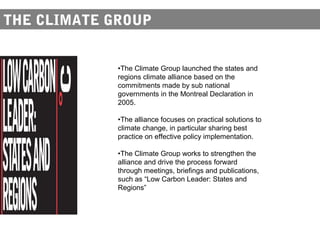The document outlines the proceedings of the Regional Development Conference held in Östersund, Sweden, focusing on climate policies, low carbon economy initiatives, and ambitious EU renewable energy goals. It discusses the Climate Group's efforts in engaging governments and corporations in implementing low-carbon technologies, such as LED street lighting and low-emission vehicles. Additionally, the document emphasizes the importance of collaboration among regions and cities to achieve substantial greenhouse gas emission reductions and energy efficiency improvements by 2020 and beyond.































